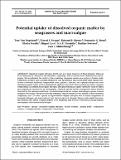Por favor, use este identificador para citar o enlazar a este item:
http://hdl.handle.net/10261/58791COMPARTIR / EXPORTAR:
 SHARE SHARE
 CORE
BASE CORE
BASE
|
|
| Visualizar otros formatos: MARC | Dublin Core | RDF | ORE | MODS | METS | DIDL | DATACITE | |

| Campo DC | Valor | Lengua/Idioma |
|---|---|---|
| dc.contributor.author | Van Engeland, Tom | - |
| dc.contributor.author | Hendriks, Iris E. | - |
| dc.contributor.author | Middelburg, Jack J. | - |
| dc.date.accessioned | 2012-10-24T11:05:02Z | - |
| dc.date.available | 2012-10-24T11:05:02Z | - |
| dc.date.issued | 2011 | - |
| dc.identifier | doi: 10.3354/meps09054 | - |
| dc.identifier | issn: 0171-8630 | - |
| dc.identifier.citation | Marine Ecology - Progress Series 427: 71- 81 (2011) | - |
| dc.identifier.uri | http://hdl.handle.net/10261/58791 | - |
| dc.description.abstract | Dissolved organic nitrogen (DON) acts as a large reservoir of fixed nitrogen. Whereas DON utilization is common in the microbial community, little is known about utilization by macrophytes. We investigated the ability of the coexisting temperate marine macrophytes Zostera noltii, Cymodocea nodosa, and Caulerpa prolifera to take up nitrogen and carbon from small organic substrates of different molecular complexities (urea, glycine, L-leucine, and L-phenylalanine) and from dissolved organic matter (DOM) derived from algal and bacterial cultures (substrates with a complex composition). In addition to inorganic nitrogen, nitrogen from small organic substrates could be taken up in significant amounts by all macrophytes. Substrate uptake by the aboveground tissue differed from that of the belowground tissue. No relationships between carbon and nitrogen uptake of small organics were found. The preference for individual organic substrates was related to their structural complexity and C:N ratio. Uptake of algae-derived organic nitrogen was of similar magnitude as inorganic nitrogen, and was preferred over bacteria-derived nitrogen. These results add to the growing evidence that direct or quick indirect DON utilization may be more widespread among aquatic macrophytes than traditionally thought. © Inter-Research 2011. | - |
| dc.description.sponsorship | This research was supported by the regional government of Andalusia project FUNDIV (P07- RNM-2516), the Spanish Project CTM2008-00012/MAR, a European Reintegration Grant (MERG-CT-2007-205675), a travel grant from Schure-Beijerinck-Popping Fund (SBP/ JK/2007-32) and the Netherlands Organization for Scientific Research. | - |
| dc.language.iso | eng | - |
| dc.publisher | Inter Research | - |
| dc.rights | openAccess | - |
| dc.title | Potential uptake of dissolved organic matter by seagrasses and macroalgae | - |
| dc.type | artículo | - |
| dc.identifier.doi | 10.3354/meps09054 | - |
| dc.embargo.terms | 2015-03-01 | - |
| dc.date.updated | 2012-10-24T11:05:02Z | - |
| dc.description.version | Peer Reviewed | - |
| dc.type.coar | http://purl.org/coar/resource_type/c_6501 | es_ES |
| item.openairetype | artículo | - |
| item.languageiso639-1 | en | - |
| item.fulltext | With Fulltext | - |
| item.grantfulltext | open | - |
| item.cerifentitytype | Publications | - |
| item.openairecristype | http://purl.org/coar/resource_type/c_18cf | - |
| Aparece en las colecciones: | (IMEDEA) Artículos | |
Ficheros en este ítem:
| Fichero | Descripción | Tamaño | Formato | |
|---|---|---|---|---|
| potential.pdf | 309,49 kB | Adobe PDF |  Visualizar/Abrir |
CORE Recommender
SCOPUSTM
Citations
40
checked on 03-may-2024
WEB OF SCIENCETM
Citations
36
checked on 21-feb-2024
Page view(s)
287
checked on 11-may-2024
Download(s)
248
checked on 11-may-2024
Google ScholarTM
Check
Altmetric
Altmetric
NOTA: Los ítems de Digital.CSIC están protegidos por copyright, con todos los derechos reservados, a menos que se indique lo contrario.
